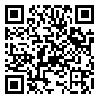Volume 9, Issue 3 (12-2022)
NBR 2022, 9(3): 200-212 |
Back to browse issues page
Download citation:
BibTeX | RIS | EndNote | Medlars | ProCite | Reference Manager | RefWorks
Send citation to:



BibTeX | RIS | EndNote | Medlars | ProCite | Reference Manager | RefWorks
Send citation to:
Khakdan F, Javanmard A S. The impact of drought stress on antioxidant activities of basil (Ocimum basilicum) cultivars extracts . NBR 2022; 9 (3) :200-212
URL: http://nbr.khu.ac.ir/article-1-3500-en.html
URL: http://nbr.khu.ac.ir/article-1-3500-en.html
Farzanegan Campus, Semnan University, Semnan, Iran , f.khakdan@semnan.ac.ir
Abstract: (6037 Views)
Basil is an important medicinal plant, belonging to the Lamiaceae family. Basil is used for the treatment of different diseases such as stomachache, headache, constipation, fever and infections, as well as to reduce and regulate the blood sugar. Moreover, Basil is known for its antibacterial, antifungal and antioxidant properties. In this study, the impact of drought stress on phenols and flavonoids concentrations, as well as the antioxidant activities of leaf extract of three basil cultivars were investigated. Seeds of basil cultivars (mikhak, green, purple) were cultivated in sand-loamy soil and drought stresses (75%, 50% and 25% of the field capacity) were applied on six-leave plants. Experiments were conducted in a completely randomized design and three repeats. Total phenols, total flavonoids and flavonols concentrations of basil leaf extracts and their antioxidant activities were measured. The maximum values (with significant differences) of three groups of non-enzymatic antioxidants and the highest levels of antioxidant activities were observed for green cultivars under mild stresses (75% of the field capacity). It was observed that antioxidant activities were elevated by the increase of the concentration of the plant extract. Drought stress results in oxidative stress in basil plants. Phenols, flavonoids and flavonols are well-known as strong antioxidants have a role in the plant’s protection against the oxidative stress. In thrice cultivars of basil which were investigated, concentrations and abilities of these compounds to inhibit free radicals were decreased by the increase of the levels of drought stresses. It seems that both basil genotypes and drought stress levels affected the production of antioxidants studied and, consequently, have impacts on the plant inhibitory abilities against the oxidative stress.
Type of Study: Original Article |
Subject:
Plant Biology
Received: 2021/10/19 | Revised: 2023/01/17 | Accepted: 2022/02/13 | Published: 2022/12/19 | ePublished: 2022/12/19
Received: 2021/10/19 | Revised: 2023/01/17 | Accepted: 2022/02/13 | Published: 2022/12/19 | ePublished: 2022/12/19
Send email to the article author
| Rights and permissions | |
 |
This work is licensed under a Creative Commons Attribution-NonCommercial 4.0 International License. |







